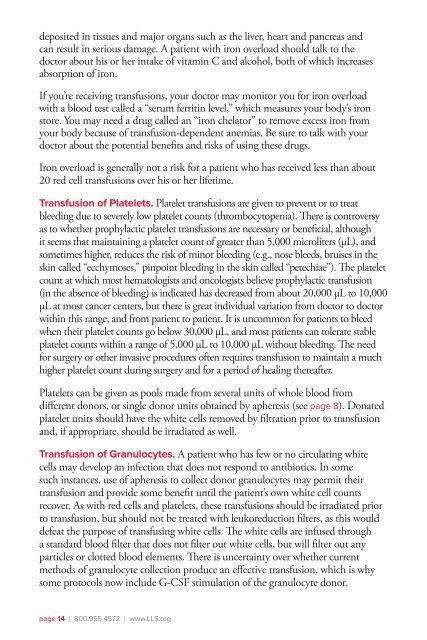Blood Transfusion (PDF) - The Leukemia & Lymphoma Society
Blood Transfusion (PDF) - The Leukemia & Lymphoma Society
Blood Transfusion (PDF) - The Leukemia & Lymphoma Society
You also want an ePaper? Increase the reach of your titles
YUMPU automatically turns print PDFs into web optimized ePapers that Google loves.
deposited in tissues and major organs such as the liver, heart and pancreas and<br />
can result in serious damage. A patient with iron overload should talk to the<br />
doctor about his or her intake of vitamin C and alcohol, both of which increases<br />
absorption of iron.<br />
If you’re receiving transfusions, your doctor may monitor you for iron overload<br />
with a blood test called a “serum ferritin level,” which measures your body’s iron<br />
store. You may need a drug called an “iron chelator” to remove excess iron from<br />
your body because of transfusion-dependent anemias. Be sure to talk with your<br />
doctor about the potential benefits and risks of using these drugs.<br />
Iron overload is generally not a risk for a patient who has received less than about<br />
20 red cell transfusions over his or her lifetime.<br />
<strong>Transfusion</strong> of Platelets. Platelet transfusions are given to prevent or to treat<br />
bleeding due to severely low platelet counts (thrombocytopenia). <strong>The</strong>re is controversy<br />
as to whether prophylactic platelet transfusions are necessary or beneficial, although<br />
it seems that maintaining a platelet count of greater than 5,000 microliters (μL), and<br />
sometimes higher, reduces the risk of minor bleeding (e.g., nose bleeds, bruises in the<br />
skin called “ecchymoses,” pinpoint bleeding in the skin called “petechiae”). <strong>The</strong> platelet<br />
count at which most hematologists and oncologists believe prophylactic transfusion<br />
(in the absence of bleeding) is indicated has decreased from about 20,000 μL to 10,000<br />
μL at most cancer centers, but there is great individual variation from doctor to doctor<br />
within this range, and from patient to patient. It is uncommon for patients to bleed<br />
when their platelet counts go below 30,000 μL, and most patients can tolerate stable<br />
platelet counts within a range of 5,000 μL to 10,000 μL without bleeding. <strong>The</strong> need<br />
for surgery or other invasive procedures often requires transfusion to maintain a much<br />
higher platelet count during surgery and for a period of healing thereafter.<br />
Platelets can be given as pools made from several units of whole blood from<br />
different donors, or single donor units obtained by apheresis (see page 8). Donated<br />
platelet units should have the white cells removed by filtration prior to transfusion<br />
and, if appropriate, should be irradiated as well.<br />
<strong>Transfusion</strong> of Granulocytes. A patient who has few or no circulating white<br />
cells may develop an infection that does not respond to antibiotics. In some<br />
such instances, use of apheresis to collect donor granulocytes may permit their<br />
transfusion and provide some benefit until the patient’s own white cell counts<br />
recover. As with red cells and platelets, these transfusions should be irradiated prior<br />
to transfusion, but should not be treated with leukoreduction filters, as this would<br />
defeat the purpose of transfusing white cells. <strong>The</strong> white cells are infused through<br />
a standard blood filter that does not filter out white cells, but will filter out any<br />
particles or clotted blood elements. <strong>The</strong>re is uncertainty over whether current<br />
methods of granulocyte collection produce an effective transfusion, which is why<br />
some protocols now include G-CSF stimulation of the granulocyte donor.<br />
page 14 I 800.955.4572 I www.LLS.org

















